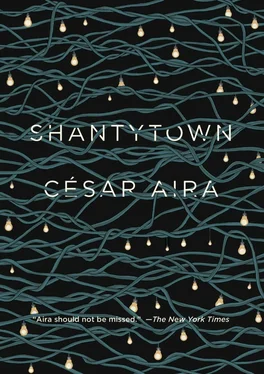The streets were very narrow, barely the width of a car, and the few ancient, rusty cars there were, often stripped of wheels or windows or doors, completely blocked the way. The strangest thing was the layout of the streets: they weren’t perpendicular to the edge of the shantytown, but ran off at an angle of about 45 degrees. Their relative straightness was also strange, given the haphazard way in which the shacks had been built. The edge of the shantytown curved away gradually, suggesting that its overall shape was an enormous circle. It was densely populated. How many people would have been living there? Tens of thousands. The streets were more or less evenly spaced, and all ran off at the same angle. And it was down one or other of those streets that Maxi went in, the first time and the following nights, depending on the address of the people he happened to be helping, who were different every time.
The overall brightness resulted from the number of light bulbs suspended in the streets. Since the electricity was free, why skimp? They were ordinary 100-watt bulbs, hanging from cables tangled in the air. It looked festive: a garland of ten little bulbs, a bunch of half a dozen, a circle of fifteen or twenty, or rows — single, double, triple — or just two bulbs and a third above them, making a triangle. . Every kind of combination, all jumbled up, in a display of fanciful creativity. It was like a natural growth, as if at this level of society — the lowest — technology had been reabsorbed by nature. As the days went by, Maxi began to realize that the number and arrangement of the bulbs was never the same from street to street: each had its own pattern of lights, which must have functioned like a name. It would have been easier to number them, but if the shantytown really was circular, as Maxi thought, numbering the streets would have been no use, because a circle has no beginning or end.
Every time he went down one of those oblique alleys, under the bunches of light bulbs, he was filled with a feeling of wonder. He felt privileged, but he didn’t know why. It was no privilege to enter that malodorous labyrinth of tin shacks, where the poorest of the poor huddled for shelter. But that was just it: he wasn’t poor, so if they invited him in, it was proof that they trusted him. He would have been willing to bet that no one he knew from school or the gym or his neighborhood and none of his family friends had ever set foot in a shantytown, or ever would. And yet they lived so close to one! It was just around the corner, really. So maybe it wasn’t a big deal, except that, in a way, it was. Outsiders never went there, for a number of reasons, which all came down to one thing: fear. It’s true that there was no real reason why outsiders would want to go there in the first place. But that was a part of the fear. And fear is the key to all places: social, geographical, even imaginary. It is the matrix of places, bringing them into existence and making it possible to move from one to another. Being or not being in a place depends on a complex system of actions, and it is well known that action engenders and nourishes fear. And besides, there must have been something to it: he’d heard that not even the police dared to go into the shantytowns.
Maxi’s feeling of wonder completely overturned an earlier belief. He had assumed that the inhabitants of the shantytown had initially kept him out because they were ashamed, and finally allowed him in when they had come to trust him and felt that they no longer had anything to hide. But that reasoning rested on assumptions about familiarization, communication, the growth of trust, or some psychological process of that kind, and any such process would have required a constant subject: that is, it could only have occurred if he had been helping the same collectors every time. But in fact they were always different.
No. It must have been something else. He began to think it might be just the opposite. It wasn’t shame or embarrassment, as he had stupidly supposed, projecting his middle-class values — why would they be ashamed of their homes, when he’d seen them rummaging through trash, looking for things to eat? — it was the other way around: they hadn’t considered him worthy, because of what he was: a rich kid with fancy clothes. And it was only by hauling carts for months and making himself useful in a thousand different ways, putting his strength and kindness at their disposal, that he had earned the right to set foot in their domain. This was like a revelation for him, and it made him see things from a different point of view.
For a start, although he wasn’t at all observant, he noticed that all the streets (if you could call those alleyways “streets”) led inward and were never intersected by others running crossways. When one street intersects with another, it means there’s a network, which seems natural: that’s the way cities have always developed. But perhaps it isn’t necessary; perhaps it’s just a convention. This destitute city within the city might have been subject to laws of its own. But the layout did seem to be rather wasteful, considering how fiercely space was saved in every other way. The overcrowding was incredible; the shacks were absurdly small and crammed together, for reasons that apparently applied to shantytowns everywhere: these settlements sprang up in strictly limited spaces, and the population was continually growing because of unplanned reproduction as well as migration from the inland provinces and neighboring countries. So great, indeed, was the pressure for space that the mere existence of streets, narrow as they were, might have seemed surprising. But rational city planning saves space by multiplying streets, not by getting rid of them. The proof of that was close at hand, in the council estate with its little houses, which the collectors had to pass through on their way back to the shantytown. The streets there were only a hundred feet apart, which meant that each house was on a plot of land fifty feet deep. In a conventional grid where the streets are a hundred yards apart, there are large unused areas at the backs of the properties. In the shantytown, the streets were forty or fifty yards apart, and if the shacks that fronted onto them had a maximum depth of sixteen feet, as it was reasonable to suppose (their size was limited by the scarcity of materials), what occupied the space between the back of one shack and the back of the corresponding shack in the next street? The answer could only be: more shacks. There must have been even poorer families living back there, who reached their dwellings via narrow passageways between the shacks with street frontage.
Anyone in the habit of walking around in cities will have wondered, at some point, what there might be in the space behind the houses; and the rare opportunities to find out (by looking out from the back of a tall building, or down a long hallway when, for some reason, a door has been left open) are never disappointing. On the contrary, discovering that our fantasies have fallen short of reality, we are spurred on to imagine spaces that are even stranger and more exotic, more hidden, more mysterious. There are manicured and overgrown gardens, woods that have sprung up unbidden, fountains, statues, swimming pools, or huge constructions, sheds built for indeterminate purposes, workshops, the follies of hobbyists: miniature reproductions of castles or cathedrals, complete with scaled-down details, lovingly crafted and accumulated over the years, tricking the eye, distorting the overall perspective, which cannot be corrected from within the block for want of reliable reference points. All such fantasies were out of place in the shantytown. But precisely for that reason, they took on another dimension, at least in Maxi’s mind. “Façade fantasies” always begin with a suspicion that treasures lie hidden, and the camouflage could be utterly banal. It was absurd to imagine literal treasures there, but in the depths of poverty, where money plays no role at all, other kinds of wealth emerge, for example the wealth of skills. This was intimated by the shantytown’s wiring system. And there was no knowing what creative skills might have developed among people who had come from faraway places, and who, for the most part, had plenty of free time because they were unemployed.
Читать дальше












